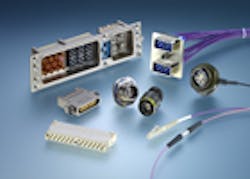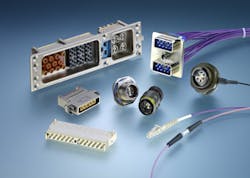Integrated Modular and Distributed Avionics Take Flight
Integrated Modular and Distributed Avionics Take Flight
Russell W. Graves
TE Connectivity
For embedded computing applications in aerospace, Integrated Modular Avionics (IMA) are an important driver in achieving flexibility. With distributed avionics gaining new popularity as a way of achieving IMA, aircraft designers are taking advantage of recent advances in packaging to make distributed systems simpler and more cost-effective. Commercial aerospace applications are moving beyond traditional protocols like ARINC 629 to higher speed Ethernet-based protocols like ARINC 664; likewise, the U.S. military is widely adopting Ethernet to take advantage of the high-volume experience in the commercial world. Already, we are seeing the release of 40-Gb/s Ethernet for military applications as application demands move beyond gigabit and 10G capabilities.Standardizing for Flexibility and Scalability
By creating standardized modules that can be mixed and matched as needed, designers gain a modular system that offers increased design flexibility compared to existing architectures in collecting and distributing throughout the aircraft. At the same time, standardization is a leading trend in the commercial aviation industry, creating more competition and ultimately driving down costs. Standardization can also allow modules to be used across different aircraft.
Figure 1 shows a distributed system for a cabin system in commercial avionics.Figure 1. Distributed avionics (Source: TE Connectivity)
Such integrated modular avionics can also reduce weight and save space. One example is the miniature modular rack principle (MiniMRP), which is being developed as an extension to ARINC 836. While similar to the established MRP systems in ARINC 836, MiniMRP modules are 40% smaller, which can also translate into weight savings of up to 60%. Standardized modules can reduce development and qualification cycles. Modules are mounted in frames, with tool-less installation and removal. Designers will ultimately have a choice of customizing a module or selecting a module in a catalog-like fashion from suppliers.
While the ARINC 836 MiniMRP is initially aimed at commercial cabin systems, it will also find use in military aerospace. The concept is applicable to a wide range of commercial and military applications.
Box-to-box connectivity is also an important issue in distributed avionics. While many links are relatively slow speed and short distances easily accommodated by copper cable, higher-speed interconnects are finding wider use. When high-speed interconnects are required, challenges arise in maintaining signal integrity over longer distances.
As I/O speeds increase, issues of signal integrity and power budgeting create new challenges. Simply put, high-speed signals are harder to manage than low-speed signals. The higher the interconnection speed, the more difficult it is to manage return loss, insertion loss, crosstalk, and similar factors that can degrade signals. While an ideal cabling system would have no intermediate connections between boxes, the real-world need for production breaks and modularity necessitates connectors in the path.



